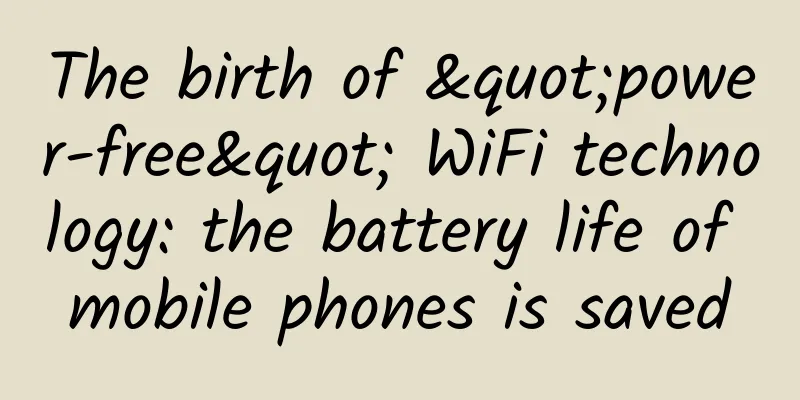The birth of "power-free" WiFi technology: the battery life of mobile phones is saved

|
Students from the School of Electrical Engineering at the University of Washington have recently developed a new Wi-Fi technology, whose greatest feature is that it consumes less than one ten-thousandth of the energy of current Wi-Fi. This technology is called "Passive Wi-Fi" and is almost the same as the routers we use today, except that it is more energy-efficient. For example, the transmission power of current routers is 100 milliwatts, while the transmission power of Passive Wi-Fi routers is only 10 to 50 microwatts, which is only one ten-thousandth of that. The new Wi-Fi technology works similarly to RFID chips, using electromagnetic back-reflection communication technology. Current Wi-Fi technology consumes electricity to provide signals; this technology is different, it selectively reflects radio waves and can also "absorb" power from radio waves. "The device using Passive Wi-Fi technology does not transmit any signal itself, it only generates Wi-Fi packets by reflection. Therefore, this is a very low energy wireless transmission technology," said Vamsi Talla, a researcher on the project. Bryce Kellogg, another researcher involved in the project, said: "It is difficult to say how much this technology will extend the battery life, because the battery life depends on many factors, such as screen brightness, but using passive Wi-Fi technology will allow the device to have almost the same battery life as when the Wi-Fi module is turned off." According to the researchers, Passive Wi-Fi works in three steps: First, a simple device needs to be installed on the wall to send analog waves to the Passive Wi-Fi sensor. Most of the power is consumed in this process, while the sensor consumes almost no power. Next, the sensor receives the analog wave and converts it into a digital form to generate a Wi-Fi data packet. Finally, the device can transmit network data to a phone or router at speeds of 11Mbps (faster than Bluetooth but slower than some home broadband). Currently, the technology has been nominated as one of the "Top Ten Technological Breakthroughs of 2016" by MIT Technology Review and has been actually applied on the campus of the University of Washington. It is reported that the technology can connect to any Wi-Fi device within 30 meters and can also penetrate walls. Best of all, each device costs less than a dollar to produce. As a winner of Toutiao's Qingyun Plan and Baijiahao's Bai+ Plan, the 2019 Baidu Digital Author of the Year, the Baijiahao's Most Popular Author in the Technology Field, the 2019 Sogou Technology and Culture Author, and the 2021 Baijiahao Quarterly Influential Creator, he has won many awards, including the 2013 Sohu Best Industry Media Person, the 2015 China New Media Entrepreneurship Competition Beijing Third Place, the 2015 Guangmang Experience Award, the 2015 China New Media Entrepreneurship Competition Finals Third Place, and the 2018 Baidu Dynamic Annual Powerful Celebrity. |
>>: The iPhone 6S only has 2GB! Is it true that more memory is better for a mobile phone?
Recommend
SAIC-GM-Wuling: SAIC-GM-Wuling's sales in Q1 2025 exceeded 377,000 units, and the new energy sector surged by 121.9%
According to recent news, SAIC-GM-Wuling's sa...
Characteristics of several common distribution channels such as Weibo and Tik Tok!
If you choose the right promotion channel , you w...
Objects can also have a sense of touch, taste and smell! How will sensor technology evolve?
Recently, the internationally renowned academic j...
How do luxury brands use UGC marketing? Key analysis of these 3 issues
Many luxury brands are reluctant to use user-gene...
Short video operation skills and case practice
With the continuous development and popularizatio...
Uncovering the secrets of Asia’s “water tower”: majestic yet fragile
Your browser does not support the video tag The Q...
Catching toads and geckos? "Punishment"! Very "punishing"!
Do you remember the news that "Two men were ...
What would happen if the FBI hacked an Android phone?
According to CNN Money, multiple sources indicate ...
Changing managers has become a habit in the United States. No one can last more than five years and the next one will have a hard time.
According to a recent comprehensive foreign news ...
How much does it cost to join the Yuncheng Gardening Mini Program? What is the price for joining the Yuncheng Gardening Mini Program?
How much does it cost to join a gardening mini pr...
Cognitive neuroscience: self and social intelligence
Self and Social Intelligence ——A person has many ...
Has the secret of the moon's "color palette" been solved? The answer lies in the lunar soil brought back by Chang'an 5!
Produced by: Science Popularization China Author:...
Eight new features! Quick review of WeChat 8.0.9 for Android
[[413904]] Previously, the iOS version of WeChat ...
A designer’s guide to artificial intelligence: basic concepts
When AlphaGo created by Google defeated the Go gr...
Factorial delivers solid-state battery B samples to BMW and Mercedes-Benz. Is the United States overtaking China?
Recently, Factorial, an American power battery ma...









